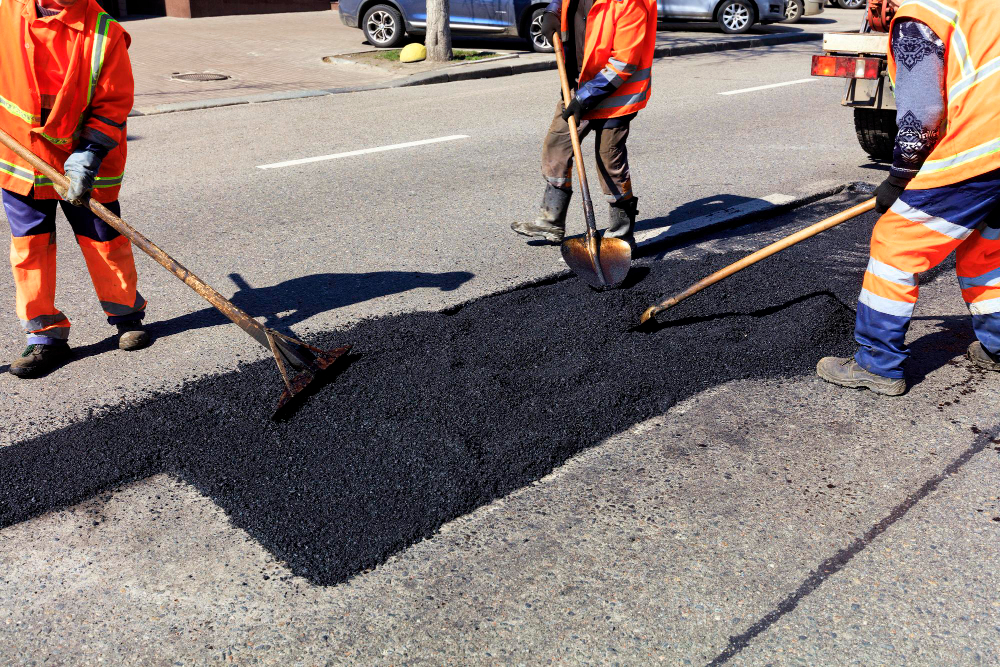
When your driveway or parking lot starts showing signs of wear, you're faced with a crucial decision: should you patch the damaged areas or resurface the entire surface? Both methods are effective asphalt repairs, but choosing the wrong approach can cost you time and money down the road.
Understanding the difference between patching and resurfacing helps property owners make informed decisions about their asphalt maintenance. Each method serves specific purposes and offers distinct advantages depending on the condition of your pavement. The key lies in accurately assessing your current situation and selecting the repair strategy that provides the best long-term value.
This guide breaks down everything you need to know about patching versus resurfacing, helping you determine which option best suits your needs and budget.
Asphalt patching involves repairing specific damaged areas of your pavement rather than addressing the entire surface. This targeted approach focuses on fixing potholes, cracks, and localized deterioration while leaving the rest of the asphalt intact.
The patching process typically involves removing the damaged asphalt, preparing the base if necessary, and installing new asphalt material in the affected area. Contractors use various techniques depending on the size and severity of the damage, from simple crack filling to full-depth reconstruction of severely damaged sections.
Patching works best when damage is limited to specific areas rather than spread throughout the entire surface. Consider patching if your asphalt has:
This repair method proves most cost-effective when less than 25% of your pavement surface requires attention. Patching also makes sense for properties with tight budgets who need immediate fixes for safety concerns.
Patching offers several advantages for property owners dealing with localized damage. The most obvious benefit is cost savings—addressing only problem areas costs significantly less than full surface replacement.
Speed is another major advantage. Patching projects typically complete within a day or two, minimizing disruption to your daily activities. You can often continue using portions of your driveway or parking lot during repairs.
Patching also extends the overall life of your asphalt by preventing small problems from becoming major issues. Water infiltration through cracks and holes can destroy the foundation beneath your pavement, leading to expensive structural repairs.
Resurfacing involves applying a new layer of asphalt over your existing pavement. This process, also called overlay, creates a fresh surface while utilizing the structural foundation already in place.
During resurfacing, contractors typically mill away a thin layer of the old surface, repair any underlying issues, and apply new hot-mix asphalt across the entire area. The new layer bonds with the existing base, creating a unified surface that looks and performs like new pavement.
Resurfacing becomes the better option when damage affects large portions of your asphalt surface. Consider resurfacing if your pavement shows:
Property owners often choose resurfacing when their asphalt is 10-15 years old and showing general wear. This approach proves more economical than patching numerous individual problem areas.
Resurfacing provides a completely renewed surface that looks and functions like new pavement. This comprehensive approach addresses current problems while preventing future issues from developing in untreated areas.
The uniform appearance of resurfaced asphalt significantly improves curb appeal and property value. Rather than having a patchwork of repairs scattered across your surface, resurfacing creates a smooth, consistent appearance.
Resurfacing also offers better long-term value when extensive repairs are needed. While the upfront cost exceeds patching, you avoid the ongoing expense of addressing multiple problem areas over time.
Cost considerations play a major role in choosing between patching and resurfacing. Patching typically costs $3-8 per square foot, while resurfacing runs $2-5 per square foot. However, these numbers can be misleading without considering the scope of work required.
For small, isolated repairs, patching offers clear cost advantages. But when damage affects large areas, the per-square-foot cost of multiple patches can exceed resurfacing expenses. Additionally, patched areas may require future maintenance sooner than resurfaced pavement.
Longevity varies significantly between methods. Well-executed patches can last 5-10 years, while resurfacing typically provides 8-15 years of service life. The key factor is matching the repair method to the extent of existing damage.
Several factors should influence your decision between patching and resurfacing. Start by honestly assessing the current condition of your asphalt. Walk the entire surface and document all areas showing damage, not just the most obvious problems.
Consider your long-term plans for the property. If you plan to sell within a few years, resurfacing might provide better return on investment through improved curb appeal. For long-term ownership, evaluate which option provides the best value over your intended timeframe.
Budget constraints obviously matter, but don't let initial cost alone drive your decision. Sometimes spending more upfront on resurfacing saves money compared to repeated patching over several years.
While understanding the basics of patching versus resurfacing helps you make informed decisions, professional evaluation ensures you choose the right approach. Experienced contractors can identify underlying issues that might not be visible to property owners.
Professional assessment also reveals whether your pavement's foundation can support resurfacing or requires more extensive reconstruction. This evaluation prevents costly mistakes and ensures your investment provides maximum longevity.
Choosing between patching and resurfacing doesn't have to be overwhelming when you have the right guidance. The best approach depends on your specific situation, from the extent of current damage to your long-term property goals.
Professional evaluation takes the guesswork out of this important decision. Experienced contractors can assess your pavement's condition, explain your options, and provide detailed cost comparisons for each approach.
If you need professional asphalt repairs in Sanford FL, contact Florida Sealcoating today for free estimates. Our experienced team will evaluate your pavement and recommend the most cost-effective solution for your specific needs.